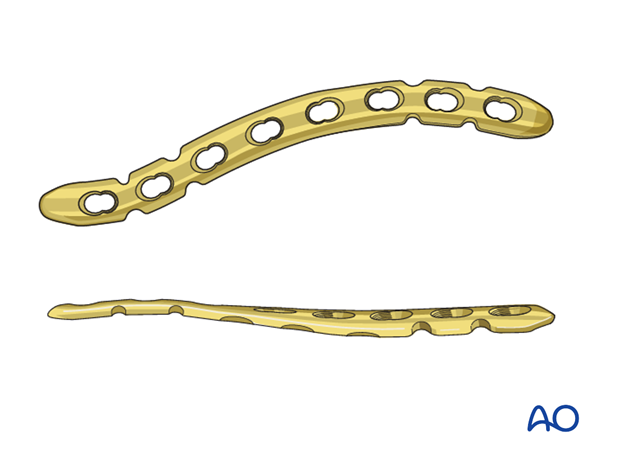ORIF - Lag screw with neutralization plate
1. Introduction
The goal of treatment for a wedge or multifragmentary fracture of the shaft of the clavicle requires restoration of appropriate alignment and length of the clavicle. This may be achievable by absolute and/or relative stability.
Note: This is the most common pattern. The deforming force on the medial end is the pull of the muscles and the deforming force on the lateral side, by far the more important is the weight of the upper extremity.
Beware of the major neurovascular bundle (subclavian artery, vein, and brachial plexus) running directly beneath the midshaft of the clavicle.

Other types of deformities may occur if the coracoclavicular ligaments are disrupted (eg, superior displacement of the lateral fragment).

Lag screws
The optimal inclination of the screw in relation to a simple fracture plane is 90°.
If amenable, one lag screw should also be inserted through the plate, which will add torsional stability.

Neutralization plate
Lag screw fixation alone is typically insufficient to withstand the normal physiologic forces. A neutralization plate is required for additional stability to distribute the forces and allow early mobilization.

Plate alternatives
We will here show the procedure with a precontoured clavicular plate which has both a bend and a twist built into it. Its shape offers advantages.

However, if a precontoured clavicular plate is not available, there are other options.
A straight plate may be used if it fits the clavicle (conventional or angle stable). If it does not, then it needs to be contoured.
This is best achieved with a slight twist at the midportion of the plate. This results in the lateral plate being applied superiorly and the medial portion anterosuperiorly. A reconstruction plate which is easier to contour may be used in smaller patients where the forces working on the plate are not as great. It is too weak for larger patients.
Biomechanically, anterosuperior or anterior plates result in mechanically stronger fixation. The exact placement of the plate will depend on the fracture pattern and the position of the fracture.

Plate length
Plate length is determined by the fracture pattern and location. If possible 3 holes proximal and 3 holes distal to the fracture region should be used.

2. Patient preparation and approach
Patient preparation
This procedure is normally performed with the patient either in a beach chair or a supine position.
Approach
For this procedure an anterior approach is normally used.

3. Reduction and fixation
Plate application
The plate is fixed with a single bicortical position screw medially or laterally depending on the fracture pattern.

Lag screw insertion
If the fracture line of the wedge is amenable to lag screw fixation through the plate, optimal compression is achieved. Inserting the screw through the plate adds torsional stability.
If the wedge cannot be fixed as above, then it should be reduced and fixed to each of the main fragments in succession with smaller cortical screws used as lag screws.
The heads should be recessed as much as possible if they come to lie under the plate.
Another combination would be that the wedge is lagged to one of the main fragments and the other fracture plane is placed under axial compression as described in the beginning of this section. The wedge depicted in this illustration has subclavius attached to it and depends on the muscle for its viability. Thus, when fixing this wedge with lag screws, outmost care must be taken not to devitalize the wedge.

Compression plating of remaining simple fracture
The fracture pattern is now reduced to a simple fracture.
A screw is inserted in the lateral segment in compression mode.

Further screws can then be inserted in the lateral segment in neutral mode.
Note: Occasionally when the fracture location is more lateral or more medial, the bone quality near the metaphysis may not offer sufficient screw purchase. In these instances, a plate offering additional screw fixation may be required (eg, longer plate, periarticular plate, locking screws).

4. Aftercare
The aftercare can be divided into 4 phases:
- Inflammatory phase (week 1–3)
- Early repair phase (week 4–6)
- Late repair and early tissue remodeling phase (week 7–12)
- Remodeling and reintegration phase (week 13 onwards)
Full details on each phase can be found here.













